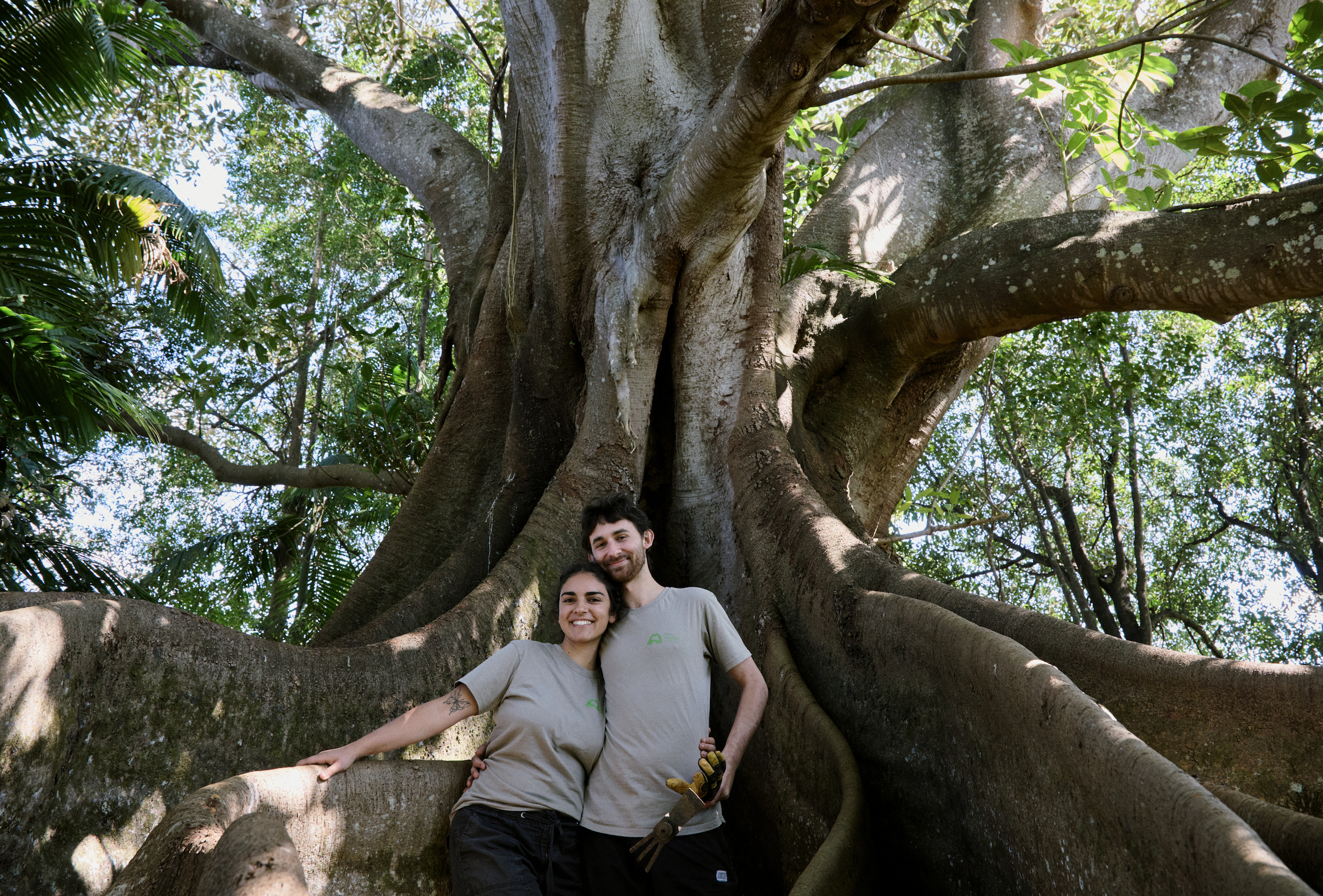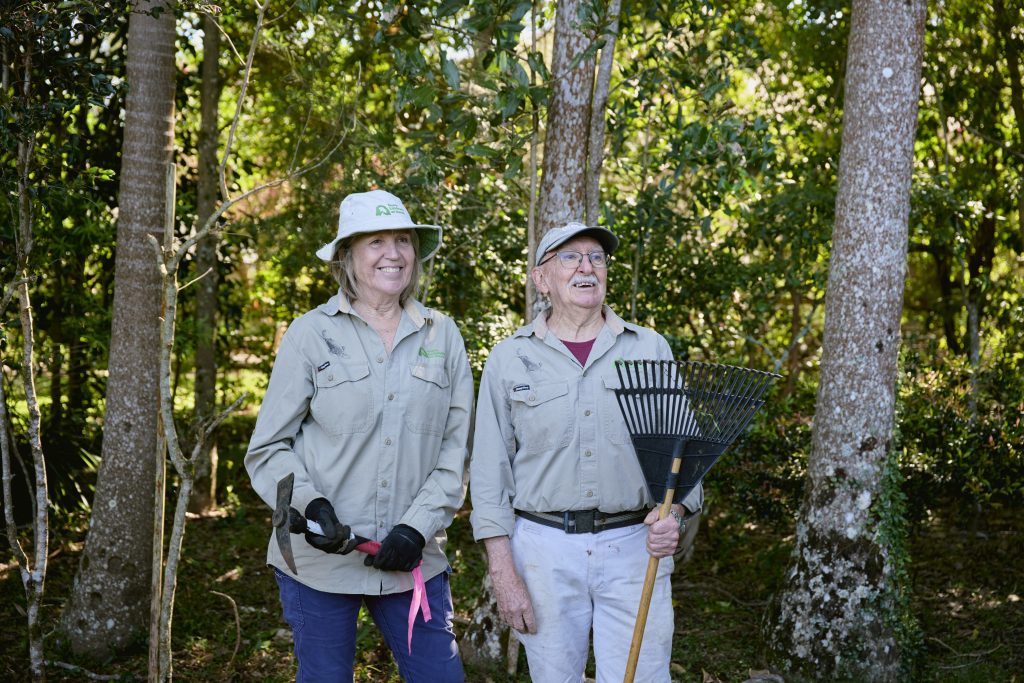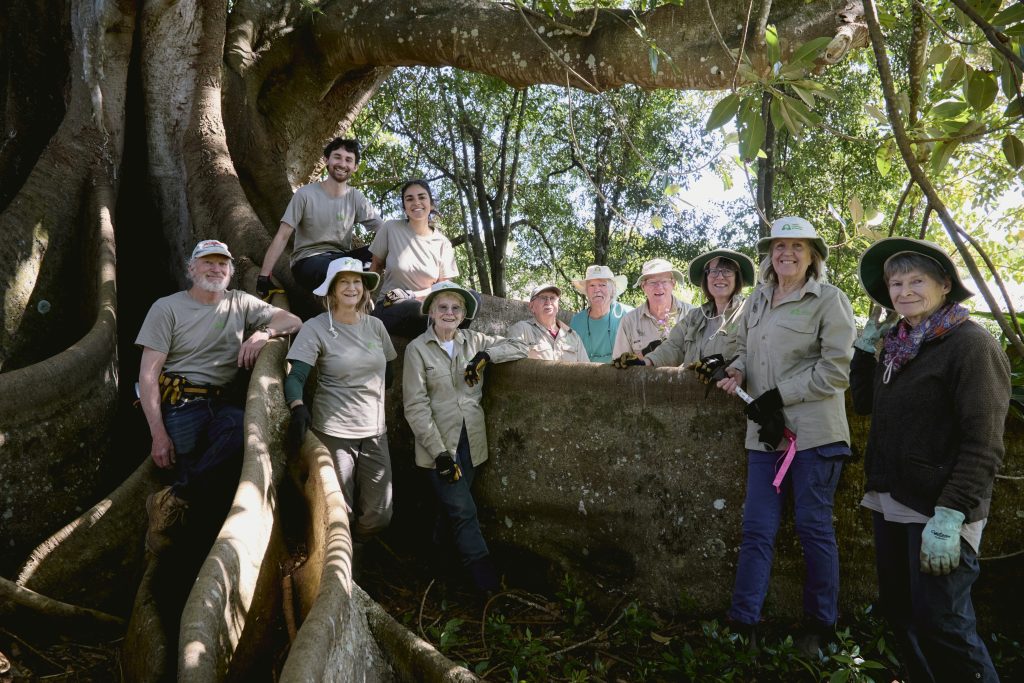
Two of the regular volunteers turning up at Bangalow Landcare’s weekly working bees are in their 20s – rare examples of young people giving their time for the good of the community, reports Digby Hildreth.
Every Saturday morning, rain gods permitting, a flock of khaki-shirted volunteers can be spotted flitting about in the bush around Bangalow, digging, watering, planting seedlings. They appear an extraordinarily vigorous crew – especially given that they quite evidently belong to a more mature demographic.
Among them, but standing out, are two members of an increasingly rare species – the younger volunteer. Oscar McMahon and Ana Assis, both 23, with straight backs and bounteous hair showing no thread of silver, have been volunteers with Bangalow Land and Rivercare for about 20 months. Most Saturdays they turn up and help renovate and restore one of the handful of remnant native forest sites around the town – beside the sports fields, along the banks of Paddy’s Creek at the bottom of Raftons Road, Little Maori Creek to the west of the town, or on the riverside walk from Piccabeen Park to Byron Creek bridge. Bushland near the Men’s Shed and at Sansom Street Reserve also benefits from the group’s loving touches.

Demographically, Oscar and Ana are outliers – and not just in Landcare. People of their age, or indeed anyone under 50, have stopped volunteering, and many organisations that need them in order to thrive have almost given up trying to recruit new members.
The Men’s Shed is maintained entirely by volunteers but is struggling to enrol young men, a problem President David Noakes feels might be because of the belief that such sheds are for oldies only.
Ruth Kirby, Bangalow CWA President, says “we are always looking for ways to entice younger women to join”, and invites anyone with ideas about how CWA could attract a younger cohort to pop in and share them.
Landcare’s recruitment efforts over the years have rarely been successful, says Robert Lotty, a stalwart of the group. He attributes the lack of interest to many young people’s obsession with their screens. As a nation, he says, “we have become more likely to stay inside rather than enjoying being in the outdoors”.
Ana and Oscar are the exception, and Bangalow Landcare President Noelene Plummer says the group is delighted to have them on board. “They bring enthusiasm and knowledge, which help to motivate us older members to keep going.” The couple have created an Instagram account aimed at reaching young followers.
Noelene co-founded the Bangalow group in 1998 and remains as enthusiastic as ever, motivated by the results achieved over the years. “We now have riparian rainforest trees where once there were eroded creek banks full of aquatic weeds. We get to see the wildlife return, the plantings have become a refuge and the banks of the creek have habitat that supports platypus as well as turtles, lizards and fish.
“When I look at the established rainforest along Byron Creek at the sports fields and the creek walk at Piccabeen Park, I realise what a difference we have made to the greening of Bangalow. These areas were once cattle paddocks with only one or two remnant trees.”
The sports field planting now constitutes a significant wildlife corridor connecting to a parcel of remnant rainforest, she says. And the group can take credit for establishing a walking track around the fields that led to today’s popular walking circuit.
“The environmental work is very rewarding,” Noelene says, “but we also enjoy socialising and sharing a lot of laughs.”
Conservation is a big inducement for Oscar and Ana but, perhaps surprisingly given the age gap, so is the social aspect – meeting like-minded people, networking, learning.
For Oscar, coming back from Melbourne, joining Landcare marked a real return to his roots: he grew up here, near his grandmother, attending Bangalow Public School and enjoying a free-range childhood, exploring the riverbanks and bush, unaware that much of it was the product of Landcare’s planting.
“I spent a lot of time down along Paddy’s Creek with a couple of my friends, building stick huts and booby traps and fishing. As a kid, that just seemed like a massive forest. I didn’t know the story,” he says.
Next came Byron High, then Melbourne University, where he and Ana met on a COVID-induced Zoom lecture on Indigenous Knowledge. As a kid he had dreamed of being “a David Attenborough type of naturalist”, and he completed a BSc, with a botany major.
Back in Melbourne following a trip to South America, the couple realised they needed to “get, like, a proper job now” and decided to give it a crack back at “home”. Both environmental scientists, they arrived with no job certainty but were soon snapped up – Oscar by Ballina Shire Council, Ana by Ecoteam in Lismore.

Ana says she didn’t know anyone here before coming north, and she wanted to meet new people in the community, and get some experience with the subtropical flora: “It’s so different to that in Victoria,” she says.
The Landcare group was “just stoked” when they joined, showering them with books, tools and protective clothing. “We instantly felt part of it,” says Ana.
“The Landcarers are just wonderful,” says Oscar. “Everybody’s there because they want to be there. And you can see the effect of what they’ve done. Like, along the All Souls planting. As a kid I remember the trees falling in the water, the bank eroding. Landcare has transformed that little area. The water runs really clear there, and there are bandicoots and emerald doves.”
Meanwhile, Lynn Smith, a member of the team that maintains Piccabeen Park, is struggling to attract new people to take on the work. “We have just four active members, all in their 70s and 80s, and we ain’t gettin’ any younger. We all love the Park and enjoy our working bee days. We are friends and are there for one another when times are tough. We have lots of laughs together. The work keeps us fit and active.” But they’re fresh out of ideas for attracting volunteers.
It’s possibly a global challenge, and a complex one, fuelled, among other things, by rising economic pressures making people time-poor. But in an age of artificial everything, individualism and disconnection, contributing some time to the community and to the environment is possibly one of the healthiest things anyone can do. As Oscar says: “It’s meditative, it’s getting your hands in the dirt, which has got to be good for your microbiome.” And we could all do with a bit more of that.
Feature image by Olivia Katz